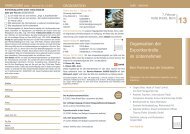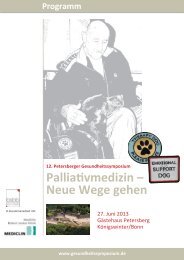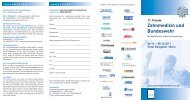TAPP – Technik, Tipps,Pitfalls. - Bsbb
TAPP – Technik, Tipps,Pitfalls. - Bsbb
TAPP – Technik, Tipps,Pitfalls. - Bsbb
Erfolgreiche ePaper selbst erstellen
Machen Sie aus Ihren PDF Publikationen ein blätterbares Flipbook mit unserer einzigartigen Google optimierten e-Paper Software.
<strong>TAPP</strong> <strong>–</strong> <strong>Technik</strong>, <strong>Tipps</strong>,<strong>Pitfalls</strong>.<br />
R. Bittner, J. Schwarz<br />
Anforderungen an ein<br />
Operationsverfahren:<br />
1. Hohe Anwendbarkeit<br />
und Akzeptanz.<br />
2. Eignung als Ausbildungsoperation.
<strong>TAPP</strong> - Hohe Anwendbarkeit und Akzeptanz<br />
Marienhospital Stuttgart, 3 / 1993 <strong>–</strong> 12 / 2007<br />
1200<br />
1000<br />
[n]<br />
n = 15101<br />
II (indirekt)<br />
4537<br />
32.2 %<br />
800<br />
IIIa (direkt)<br />
5594<br />
40.8 %<br />
600<br />
IIIb (ind./komb.)<br />
IIIc (femoral)<br />
3096<br />
483<br />
22.9 %<br />
3.6 %<br />
400<br />
IV (Rez. Hernie)<br />
1965<br />
13.0 %<br />
skrotal<br />
807<br />
5,3%<br />
200<br />
irreponibel<br />
477<br />
3.2 %<br />
0<br />
'92 '93 '94 '95 '96 '97 '98 '99 '00 '01 '02 '03 '04 '05 '06 '07<br />
inkarzeriert<br />
161<br />
1.1 %<br />
offen [Shouldice, Lichtenstein]<br />
laparoskopisch [<strong>TAPP</strong>]
<strong>TAPP</strong> <strong>–</strong> Erlernbar = Ausbildungsoperation!<br />
%<br />
Rezidivrate nach <strong>TAPP</strong> [n=15101]<br />
1993 - 2007 ( n = 106; 0,70 %)<br />
9<br />
n =15<br />
8<br />
7<br />
6<br />
5<br />
Missed Defekt n= 3 (3.3%)<br />
Netz zu klein n=14 (15,2 %)<br />
Geschlitztes Netz n=16 (17,4%)<br />
Netz Dislokation n=59 (64,1%)<br />
mesh<br />
15 cm<br />
10 cm<br />
4<br />
n =16<br />
3<br />
2<br />
1<br />
n=7 n=10 n=10 n=4 n=7 n=4 n=8 n=0 n=8 n=4 n=6<br />
n=3<br />
n=4<br />
0<br />
'93 '94 '95 '96 '97 '98 '99 '00 '01 '02 '03 '04 '05 '06 '07<br />
[Year]
<strong>TAPP</strong> <strong>–</strong> Erlernbar = Ausbildungsoperation!<br />
Rezidivrate<br />
[%]<br />
4,5<br />
4<br />
3,5<br />
3<br />
2,5<br />
2<br />
1,5<br />
1<br />
0,5<br />
0<br />
50 100 150 200 250 300 350 400 450 500<br />
[n/Chirurg]<br />
4 Pioniere der <strong>TAPP</strong> (erfahrene konv.<br />
Chirurgen)<br />
5 <strong>TAPP</strong> Anfänger<br />
Exzellente Resultate<br />
von Anfang an!<br />
median Rez. rate<br />
(total)<br />
n=15101<br />
<strong>TAPP</strong> ist lernbar !
<strong>TAPP</strong> <strong>–</strong> Erlernbar = Ausbildungsoperation!<br />
Chirurg [Nu.] Hernien [n] OP-dauer [min] Morbidität [%] Rez.-rate [%]<br />
1 5507 38 2,1 0,76<br />
2 2159 40 3,7 0,7<br />
3 1324 40 3,5 0,91<br />
4 1195 42 2,1 0,25<br />
5 1130 40 1,8 0,26<br />
6 836 48 2,4 0,36<br />
7 839 45 1,2 0,24<br />
8 403 44 2,0 0,25<br />
9 237 50 1,7 0,36<br />
10 216 48 - -<br />
11 207 60 1,9 0,96<br />
12 152 55 1,3 -<br />
13 115 56 - 1,2<br />
14 108 60 3,7 0,9<br />
15 100 50 - -<br />
16 87 55 - -<br />
17 44 60 4,5 -<br />
18 43 65 -<br />
19 34 65 -<br />
20 18 72 -<br />
21 16 75 -<br />
22 3 64 -<br />
Gast 15 75 -
<strong>TAPP</strong> - eine schwierige Operation!!!<br />
Warum soll/ muss die <strong>Technik</strong> erlernt werden
European Hernia Society guidelines on the treatment<br />
of inguinal hernia in adult patients.<br />
M.P. Simons, T.Aufenacker, M. Bay-Nielsen, J.L. Bouillot,<br />
G. Campanelli, J. Conze, D. de Lange, R. Fortelny, T. Heikkinen,<br />
A. Kingsnorth, J. Kukleta, S. Morales-Conde, P. Nordin,<br />
V. Schumpelick, S. Smedberg, M. Smietanski, G. Weber, M.<br />
Miserez.<br />
Hernia (2009) 13: 343-403
European Hernia Society guidelines on the treatment<br />
of inguinal hernia in adult patients.<br />
Grade<br />
A<br />
Recommendations<br />
All male adults (>30 years) patients with a symptomatic<br />
inguinal hernia should be operated on using a mesh<br />
technique.<br />
The open Lichtenstein and endoscopic inguinal hernia<br />
techniques are recommended as the best evidence-based<br />
options for the repair of a primary unilateral hernia,<br />
providing the surgeon is sufficiently experienced in the<br />
specific procedure.<br />
For the repair of a recurrent hernia after conventional<br />
open repair, endoscopic inguinal hernia techniques are<br />
recommended.
European Hernia Society guidelines on the treatment<br />
of inguinal hernia in adult patients.<br />
Recommendations<br />
Grade<br />
A<br />
It is recommended that, from a hospital perspective, an<br />
open mesh procedure is used for the treatment of inguinal<br />
hernia.<br />
From a socio-economic perspective an endoscopic<br />
procedure is proposed for the active working population,<br />
especially for bilateral hernias.
European Hernia Society guidelines on the treatment<br />
of inguinal hernia in adult patients.<br />
Recommendations<br />
Grade<br />
A<br />
When only considering pain, endoscopic surgery is<br />
superior to open mesh.<br />
It is recommended that an endoscopic technique is considered<br />
if a quick postoperative recovery is particularly<br />
important.
Is open surgery a risk factors for chronic<br />
pain<br />
Consensus Conference (Delhi 19.02.09- 21.02.09)<br />
Arregui M, Bisgaard T, Bittner R, Chowbey P, Dudai M, Ferzli<br />
G,Fitzgibbons R,Fortelny R,Köckerling F, Kuhry E, Kukleta J,<br />
Miserez M, Misra M, Montgomery A, Rosenberg J,<br />
Reinpold W, Schwarz J, Singh K, Weyhe D.<br />
International<br />
Endohernia<br />
Society (IEHS)<br />
Guidelines
Risk factors for chronic pain <strong>–</strong><br />
operative technique<br />
W. Reinpold<br />
Analyses of studies:<br />
IA 11<br />
IB 39<br />
IIA 3<br />
IIB 20<br />
III 11<br />
IEHS-<br />
Guidelines<br />
Level<br />
1A<br />
Level<br />
1B<br />
Statements<br />
The risk of acute and chronic pain<br />
is lower after endoscopic groin<br />
hernia repair compared to open<br />
surgery with or without mesh.<br />
There is no difference of acute and<br />
chronic pain after TEP and <strong>TAPP</strong>.<br />
Surg Endosc ( in press)
Risk factors for chronic pain <strong>–</strong><br />
operative technique<br />
Recommendation<br />
Grade<br />
A<br />
To reduce acute pain and the<br />
risk of chronic pain after<br />
inguinal hernia repair the<br />
endoscopic techniques (<strong>TAPP</strong> and<br />
TEP) must be preferred to<br />
IEHS-<br />
Guidelines<br />
Surg Endosc ( in press)<br />
open mesh or non-mesh<br />
repair if expertise is present.
<strong>TAPP</strong> <strong>–</strong> die Vorteile kommen nur zum<br />
Tragen, wenn die Operation sicher<br />
durchgeführt werden kann - die<br />
Entscheidung fällt im OP.<br />
Workshop Ho Shi Min City 2008
Die <strong>Technik</strong> ist entscheidend ! :<br />
Operative Morbidität<br />
Dauer der Arbeitsunfähigkeit<br />
Chronische Schmerzen<br />
Rezidivrate
<strong>TAPP</strong> - <strong>Tipps</strong> zur <strong>Technik</strong> I:<br />
Plica umb.<br />
medialis<br />
Epigastric vessels<br />
• Weite Eröffnung<br />
des Peritoneums<br />
• Einstieg in den präperitonealen<br />
Raum<br />
besser von lateral!<br />
D. deferens<br />
Sp. iliaca<br />
ant. sup.<br />
Iliac artery<br />
Testicular vessels
<strong>TAPP</strong> -<br />
<strong>Tipps</strong> zur<br />
<strong>Technik</strong> II:<br />
Vor Dissektion und Reposition<br />
eines indirekten Bruchsacks<br />
Epigastrische Gefäße<br />
Merke:<br />
Testiculargefäße<br />
Bei unklarer Hernientopographie<br />
zuerst die Testiculargefäße<br />
darstellen (laterocaudal)<br />
und die Gefäße als<br />
Leitstrukturen benutzen.<br />
Harnblase
<strong>TAPP</strong> - <strong>Tipps</strong> zur <strong>Technik</strong> III:<br />
Ungenügende Parietalisierung kann zur Netzdislokation<br />
mit konsekutiven Rezidiv führen !<br />
Adhäsionen zwischen Peritoneum<br />
und fascia spermatica.
Merke : Am Ende der Dissektion sollten alle<br />
anatomischen Landmarken klar und<br />
fettfrei dargestellt sein !<br />
Myopectinal orifice<br />
acc. to Fruchaud
<strong>TAPP</strong> - <strong>Tipps</strong> zur <strong>Technik</strong> IV:<br />
Merke:<br />
Alle Lipome oder anderes präperitoneales Fettgewebe<br />
sollte oberhalb und nicht unterhalb<br />
des Netzes positioniert werden !<br />
Lipoma<br />
wenigstens 1 to 2 cm<br />
Parietalisierung
<strong>TAPP</strong> - <strong>Tipps</strong> zur <strong>Technik</strong> V:<br />
Wichtgste Rezidivursache : zu kleines Netz<br />
Neumayer et al<br />
N Engl J Med 2004;<br />
350 :1819-1827<br />
Rezidivrate :<br />
offen 4 %<br />
lap 10,1 %<br />
Subanalyse:<br />
Patienten mit Rez. ohne Rez.<br />
8,1+/- 0,6 cm 8,5 +/- 1,3 cm<br />
p< 0,001<br />
Netzgröße 6 x 11 cm<br />
In „Minimal Invasive Chirurgie“ Hrsg. A.Pier,E.Schippers ,Thieme 1995<br />
Mindestgröße: 10 x 15 cm !!!
Ileo-pubic tract<br />
<strong>TAPP</strong> - <strong>Tipps</strong> zur <strong>Technik</strong> VI:<br />
Zu viele und falsch<br />
plazierte Clips:<br />
Schmerzen!<br />
In Surgical Textbook „Min.-Inv. Chir“.“<br />
Hrsg.K.Kremer et al Thieme 1995<br />
Ileo-pubic tract<br />
VD<br />
GB<br />
FB<br />
IP<br />
FN<br />
GN<br />
LC<br />
IS<br />
IL<br />
Triangle of doom<br />
and triangle of pain<br />
Acc. to Annibali/Arregui
C. Taylor et al, Surg Endosc 2008;22:757-762<br />
An association was also found between the number<br />
of fixation tacks used and the incidence of pain.
Fehlervermeidung bei der <strong>TAPP</strong><br />
Fall 2 Mann, 49 J.,<br />
‣ OP 06.07.09, lap. Hernioplastik bds. 25 Clips/Tacks<br />
geschlitztes Netz, 6x11 cm<br />
Postoperative starke Schmerzen bds. Leistenregion.<br />
Unfähigkeit zu Gehen für 7 Tage. Unter Schmerzmittel<br />
allmähliche Besserung, bei stärkerer Belastung wieder<br />
Zunahme. Schmerzen beim Urinieren, Stuhlgang und<br />
Sexualität.<br />
Bisher kein operativer Eingriff, Patient fürchtet aber Rezidiv<br />
wegen der zu kleinen Netze.
Komplikationen nach laparoskopischer Hernioplastik<br />
<strong>–</strong> medico-legale Konsequenzen<br />
Frau, 43 J., BMI 20,3<br />
‣ OP 16.06.05, lap. Hernioplastik bds. 25 Tacks<br />
‣ Entlassung 24.06.2005<br />
‣ Amb. Vorstellung 27.6, 24.8, 29.8, 7 Schmerzpunkte<br />
‣ Arztmigration<br />
‣ Vorstellung 8.9 Schmerzen<br />
‣ Vorstellung 22.9. DS, Abwehr re. Mittel / Unterbauch, Wandverdickung<br />
Kolon ascendens<br />
‣ OP 6.11. Entfernung 12 Tacks, Fistel zum Coecum<br />
‣ 4.01.06 Entfernung 13 Tacks + Netzentfernung bds<br />
FEHLER <br />
OP <strong>–</strong> Indikation: unerträgliches Fremkörpergefühl,<br />
das Pat. vollkommen behindere
Die optimale <strong>Technik</strong> zur sicheren<br />
Hernienversorgung sollte<br />
Hernien-, Patienten- und Kosten-adaptiert sein.<br />
Unsere Strategie<br />
Standard: 10 x 15 cm Netz (leichtgewichtig +<br />
grossporig)<br />
Atraumatische Fixation<br />
mit Fibrin<br />
Ausnahmen - Kleine Hernie < 3 cm:<br />
keine Fixation,<br />
hydrophiles Netz<br />
- Direkte Hernie > 3 cm<br />
Clip fixation<br />
- Herniendefekt > 5 cm:<br />
Netzgrösse 12 x 17 cm + Fibrinklebung<br />
ggf. +Clip (direkten H.)
<strong>TAPP</strong> - <strong>Tipps</strong> zur <strong>Technik</strong> VII:<br />
Was man nicht machen soll!
<strong>TAPP</strong> - <strong>Tipps</strong> zur <strong>Technik</strong> VII:<br />
Wie man es machen soll ! : Verschluß des Peritoneums<br />
mit Naht: Keine Ileus Gefahr
<strong>TAPP</strong> <strong>–</strong> <strong>Technik</strong>, <strong>Tipps</strong>,<strong>Pitfalls</strong>.<br />
Zusammenfassung<br />
1. Hohe Anwendbar- und Patientenfreundlichkeit.<br />
2. Geeignet als Ausbildungsoperation.<br />
3. Vorteile gegenüber der offenen Operation<br />
bezüglich aller schmerzassozierten Parameter.<br />
„Paris-Roubaix“ 3 Wochen nach <strong>TAPP</strong><br />
„ Giro“ 1 Jahr nach <strong>TAPP</strong>
<strong>TAPP</strong> <strong>–</strong> <strong>Technik</strong>, <strong>Tipps</strong>,<strong>Pitfalls</strong>.<br />
Zusammenfassung<br />
4. Die standardisierte <strong>Technik</strong> ist der Schlüssel<br />
zum Erfolg.<br />
5. Durch strukturierte Ausbildung und kontinuierliches<br />
Training, möglichst in einem Zentrum, können<br />
Fehler weitestgehend vermieden werden.










